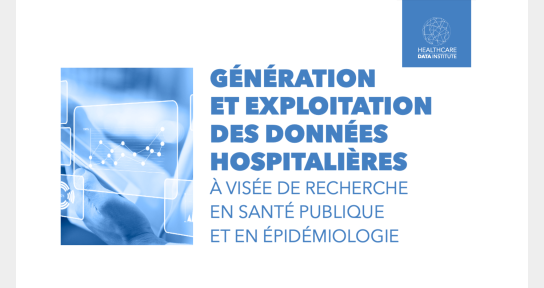There are numerous reasons for which the use of data is extremely valuable for health-care companies. The word “data” here encompasses all sorts of data, from the data generated through clinical trials, real-life registries… called “clinical data”, to national medico-administrative databases (PMSI, SNIIRAM…) called “medico-administrative data”.
The fundamental difference between both types of data is that clinical data are generated to answer a very specific clinical question whereas medico-administrative data are generated for financial requirements (this is the data used by national health insurance to ensure appropriate fees to hospitals, doctors, nurses, radiologists…) thus collating numerous valuable data, but without a specific clinical output. However, these data can be extrapolated to provide some simple clinical information (death, reintervention, visit to a specialist, drug prescriptions…) and these databases present the enormous advantage of being almost exhaustive all over the French national territory.
Coverage of the healthcare needs
a. Territory attractiveness
First of all, medico-administrative data help assess and understand the healthcare needs on the territory. Indeed, it gives a very accurate picture of the patients suffering a specific disease, the way they are disseminated across the territory (through their postal codes) and where and how they are treated, thus providing information on healthcare coverage. Therefore, these data have an impact in terms of territory attractiveness (the decision to invest in a specific country or not) – on the contrary, not knowing the market needs in advance prevents from investing in a country, usually companies being risk-adverse to blind decisions.
b. Company structure to ensure the appropriate organization to answer the delivery of the MD associated services based on the number of patients and their concentration
In the area of medical devices specifically, a lot of services are associated to the products (consignments, sterilization of the ancillaries, specific trainings and technical support on the equipment…) and it is necessary for a company to organize its structure according to the healthcare needs. In fact, providing support to 1000 patients treated in 100 hospitals across the territory is clearly different from 1000 patients treated in 10 hospitals, and the info of where the need is and where the providers are can drive the local organization of the structure of the company.
c. Allow for an equal access to healthcare services on the national territory
Finally, on top of driving investments, at a national and local level, and allowing for the right organizational structure of local-based companies to ensure the right level of services associated to medical devices, this granular medico-administrative data also plays a role in providing equal access to healthcare of all the patients on the national territory.
Indeed, the information of the postal code of the patients and the hospitals/centers where they are treated helps companies understand where a technology is needed to prevent regional inequalities in terms of healthcare access. Currently these info are publicly available, but there is a major risk that the rules will change in the near future (Loi de Santé), then creating huge difficulties for companies to appropriately answer the healthcare demand.
Participation to the National Health Strategies
One of the roles of healthcare companies is also to participate to the National Health Strategies set by the Ministry of Health. As such they can help their customers (whether public or private hospitals, GPs, specialists, nurses…) by raising their awareness on specific topics and thus motivating them to take actions. As an example, the publication1 on the clinical and economic burden of healthcare-associated infections during hospitalization for surgery in France aimed to estimate the healthcare burden associated with healthcare-associated infections (HAIs) following surgery in France, and explored the potential impact of infection control strategies and interventions on the clinical and economic burden of disease. Data on the frequency of HAIs were gathered from the 2010 Programme de Médicalisation des Systèmes d’Information (PMSI), and cost data were taken from the 2009 Echelle Nationale de Coûts à Méthodologie Commune (ENCC). It was estimated that 3% of surgical procedures performed in 2010 in France resulted in infection, resulting in an annual cost of €57 892 715. Patients experiencing a HAI had a significantly increased mortality risk (4·15-fold) and an increased length of hospital stay (threefold). Scenario analysis in which HAI incidence following surgery was reduced by 8% (based on a study of the effectiveness of triclosan-coated sutures), suggested that, annually, 20 205 hospital days and €4 588 519 could be saved. Analyses of 20% and 30% reductions in incidence (based on an estimate of the number of preventable nosocomial infections) suggested that annual savings of €11 548 057 and €17 334 696, respectively, could be made. This study aimed at convincing hospitals that 1) HAI was associated to a high burden 2) infection control processes, which reduce HAI incidence during hospitalization for surgery, have the potential to provide valuable cost savings to healthcare providers.
The problem with HAI is that every hospital recognizes that the problem happens with other hospitals, but rarely acknowledges that it happens with themselves. Thus a detailed tool was developed by the industry, which evaluated for each and every hospital, the number and cost of healthcare associated infections, compared to a national or regional average. The aim of this tool was to raise the awareness locally on a subject where hospitals tend too often to think that they have no problem at all, in order to lead them to take actions in putting infection control strategies into place and reduce the burden associated to these infections.
Answer to the Healthcare Authorities requirements
a. Post-reimbursement studies
Last but not least, National Health Authorities tend to require more and more real life data following the reimbursement of drugs or devices in order to maintain reimbursement over the years. The generation of such data is long, costly, and has many times proven ineffective (especially in the device area, by lack of motivation of the surgeons, too many lost to follow up, difficulty of inclusion…). An alternative to regular clinical cohort studies may be, in certain specific cases, the use of medico-administrative databases.
For example, the case of carotid stents reimbursement may prove in the near future, that medico-administrative data can be useful to generate post-reimbursement studies.
In 2009, 5 carotid stents, from 5 different companies, were accepted for reimbursement at the condition that they come back 3 years later with a post-reimbursement registry measuring the cumulative morbi-mortality rate at 30 days of implanted patients, by indication, device trademark, type of practitioner, activity size of the hospital. A working group of these medical devices companies was put into place in order to run a joint clinical study. But 3 years afterwards, it happened that the scientific community did not see any interest in such a trial as available clinical data on the technique was already quite comprehensive. Therefore, the WG of medical devices companies, together with the French scientific society, proposed an alternative solution to HAS and CEPS, by using SNIIRAM data. As the database was not initially created to fulfill a clinical requirement, some of the clinical variables are not available in the database (type of stroke, type of practitioner, detailed indication, peri-operative medical treatment….), but at the same time such a study also gives the opportunity to get access to all the patients implanted with carotid stents and not only a sample. Info on death and re-interventions, as well as size of hospital activity are registered which were the main requests of HAS and CEPS. After 15 months of administrative process, the access to the data has been granted and the study is being processed. Indeed, it is to be noted that SNIIRAM data are not public and need specific authorization from different administrative bodies which, when granted, allow the access to a specific extraction of the data to be exclusively used for the submitted protocol of the study.
On top of providing info on all the implanted patients, this type of study proves also to be much less expensive than real clinical data generation, and could be quite quick to implement (without the administrative process to get access to the database).
The very recent publication by ANSM of a population based study on the association between total hip replacement characteristics and 3-year prosthetic survivorship2 has already proven that such a methodology was valid and that the database could serve as a rich tool to access follow-up information on implants listed on the LPP (with a specific code)
b. Need for comprehensive follow-up
At a time where it’s expected from healthcare companies to have a more comprehensive understanding and follow-up of the patients using their products, medico-administrative data can help analyze patients pathways . As an example, the publication3 investigating the influence of bariatric surgery on medical management and costs in France can be cited. It has indeed been run exclusively on EGB data (EGB is a 1/97 sample of the SNIIRAM database) and has shown that bariatric surgery reduced the consumption of anti-diabetes drugs as well as hypertensive drugs. It’s a new way of proving that bariatric surgery had a positive impact not only on weight, but also on serious co-morbidities (diabetes, hypertension) which are a huge burden in terms of public health.
—
Karine SZWARCENSZTEIN Director Health Economics, Market Access & Reimbursement at Johnson & Johnson Medical Devices. Karine is a member of the Healthcare Data Institute.
—
References
1. Lamarsalle, L., Hunt, B., Schauf, M., Szwarcensztein, K. and Valentine, W.J. (2013) Evaluating the Clinical and Economic Burden of Healthcare-Associated Infections during Hospitalization for Surgery in France. Epidemiology and Infection, 141, 2473-2482.
2. Colas S, Collin C, Piriou P, Zureik M. Association Between Total Hip Replacement Characteristics and 3-Year Prosthetic Survivorship : A Population-Based Study. JAMA Surg. 2015 Aug 19. doi: 10.1001/jamasurg.2015.1325. [Epub ahead of print]
3. Czernichow S, Moszkowicz D, Szwarcensztein K, Emery C, Lafuma A, Gourmelen J, Fagnani F. Impact of Bariatric Surgery on the Medical Management and Costs of Obese Patients in France: an Analysis of a National Representative Claims Database. Obes Surg. 2014









